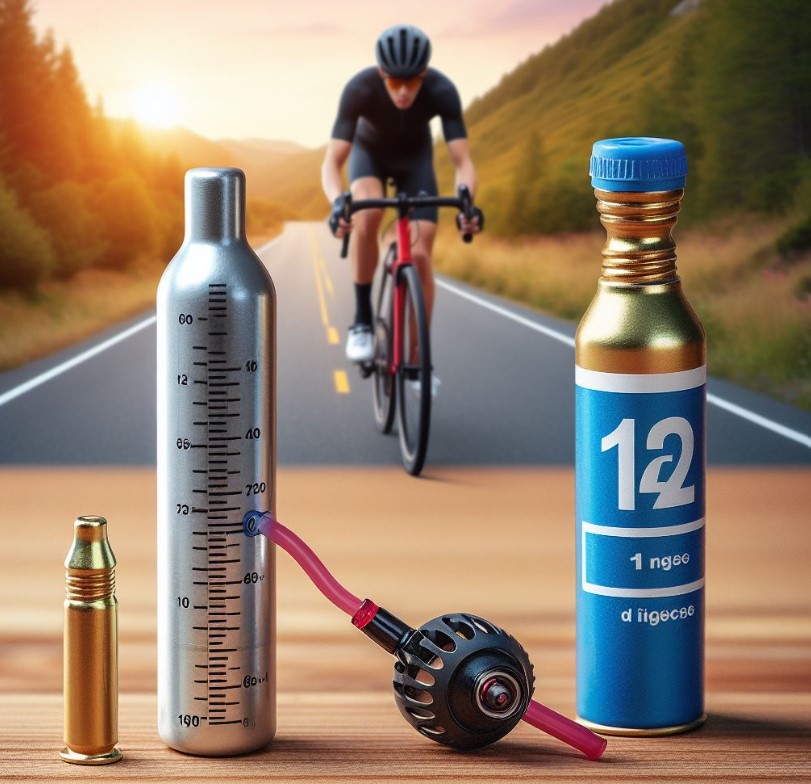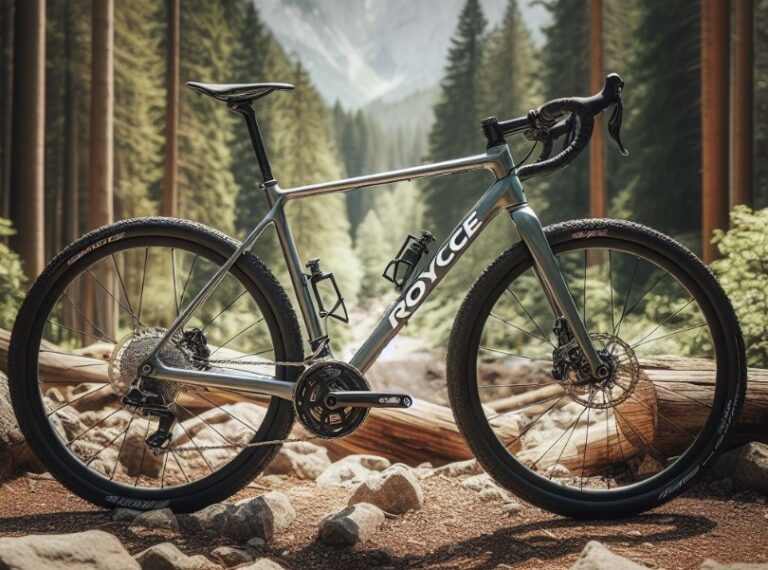What Size Co2 Cartridge For Road Bike? Answered
This article aims to provide information on What Size Co2 Cartridge For Road Bike? Navigating the world of cycling, one crucial accessory that stands out for its efficiency and convenience is the CO2 cartridge, a lifesaver during those unexpected flat tires. Selecting the right size CO2 cartridge for your road bike is essential to ensure you’re back on the road swiftly. This guide delves into the specifics, helping cyclists make informed decisions on the optimal cartridge size for their road biking adventures.
Key Takeaways
- The most common CO2 cartridge sizes for road bikes are 16g and 25g.
- A 16g cartridge can fully inflate a road bike tire to 90-120 PSI, suitable for most situations.
- For larger tires or those requiring higher pressures, a 25g cartridge may be necessary.
What Size Co2 Cartridge For Road Bike?
For most road bikes, a 16g CO2 cartridge is the ideal choice, capable of inflating a tire to the standard pressure range of 90-120 PSI, ensuring a smooth and efficient ride.

Choosing the Right Size CO2 Cartridge for Your Road Bike
When it comes to selecting the right size CO2 cartridge for your road bike, the main consideration is the volume of air needed to inflate your tire to the optimal pressure. Road bike tires typically require between 90 and 120 PSI, which affects the size of the CO2 cartridge you should carry.
16g CO2 Cartridges
The 16g CO2 cartridge is the most popular choice among road cyclists. It strikes a perfect balance between size and capacity, capable of inflating a standard road tire to about 90-120 PSI with a single cartridge. This size is ideal for those prioritizing weight and space efficiency in their kit.
25g CO2 Cartridges
For cyclists who ride on larger tires or prefer higher pressures, the 25g CO2 cartridge is a better fit. It provides more air to ensure that larger-volume tires can be inflated adequately. This size is slightly bulkier but a must-have for certain rides and conditions.
How to Use a CO2 Cartridge for Tire Inflation?
Using a CO2 cartridge requires a bit of know-how to ensure efficient and safe tire inflation. Here’s a brief guide on how to use them effectively.
Step-by-Step Guide
- Remove the flat tire: Firstly, remove the tire and replace or patch the tube as necessary.
- Prepare the CO2 inflator: Attach the CO2 cartridge to the inflator head, ensuring it’s secure but not pierced yet.
- Attach to the valve: Secure the inflator head to the tire valve.
- Inflate the tire: Pierce the cartridge to release the CO2 and inflate the tire. Control the flow to avoid over-inflation.
Safety Tips
- Always wear gloves when handling CO2 cartridges, as they become extremely cold when discharged.
- Ensure the tire is properly seated on the rim before inflating to avoid accidents.
Benefits of CO2 Cartridges Over Traditional Pumps
CO2 cartridges offer several advantages over traditional hand pumps, making them a favored choice for many cyclists.
Speed and Efficiency
CO2 cartridges inflate tires much faster than hand pumps, saving time and effort, especially during races or long rides.
Compactness and Weight
These cartridges are small and light, making them easy to carry in a pocket or saddlebag, unlike bulkier hand pumps.
Should I Use 16 Or 25 G CO2?
Choosing between a 16g and 25g CO2 cartridge depends on the size of your tire and the pressure requirements. 16g cartridges are generally sufficient for road bikes, as they can typically inflate a single road tire to 90-120 PSI, perfect for most road cycling conditions. These cartridges are favored for their compactness and lighter weight, making them easy to carry during rides.

25g cartridges, on the other hand, are designed for larger volume tires or situations where a higher PSI is necessary. They are ideal for mountain bikes, fat bikes, or when you need to inflate a road bike tire above 120 PSI. Due to their larger size, they can be a bit bulkier to carry but are indispensable for specific cycling needs.
In summary, for most road bike applications, a 16g cartridge is adequate and efficient. Opt for a 25g cartridge if you’re dealing with larger tires or require a higher inflation pressure.
How Much Psi Is In A 16g CO2 Cartridge Road Bike?
A 16g CO2 cartridge can typically inflate a road bike tire to between 90 and 120 PSI. The exact amount of PSI you can achieve depends on several factors, including the volume of the tire, its size, and the initial pressure before inflation.
For a standard 700c road tire (23-25mm width), you can expect a 16g cartridge to fill it to the higher end of this range. For slightly larger tires (28mm or above), the pressure achieved may be at the lower end of the range. It’s important to note that external factors like temperature can also slightly affect the CO2’s expansion and thus the final pressure.
What Are 16g CO2 Cartridges Used For?
16g CO2 cartridges are predominantly used for inflating bicycle tires quickly and efficiently, especially in situations where time is of the essence, such as during races or long-distance rides.

Their compact size and the quick inflation they offer make them a favorite among road cyclists and triathletes. Besides cycling, 16g cartridges are also used in other applications requiring small, pressurized CO2 sources, such as in airsoft, for inflating life jackets, or in certain handheld tools.
However, their primary use in the context of cycling is to provide a rapid means of getting a flat tire back to a rideable pressure without the need for a bulky or time-consuming manual pump.
How Much CO2 Does Your Bicycle Tire Need?
The amount of CO2 your bicycle tire needs depends on the tire’s volume and the desired pressure (PSI). Road bike tires, which are typically narrower, require less CO2 to reach high pressures compared to mountain bike tires, which are wider and usually inflated to lower pressures. Here’s a rough guide to help you estimate:
- Road bikes (700c x 23mm): Approximately 90-120 PSI can be achieved with a 16g cartridge.
- Mountain bikes (26″, 27.5″, or 29″ x 2.1-2.4″): A 25g cartridge is often needed to reach the desired 30-50 PSI, depending on tire volume.
- Gravel or Cyclocross bikes (700c x 30mm-40mm): These may require between 16g to 25g of CO2, with a specific amount depending on the tire size and the desired pressure.
Ultimately, the best approach is to carry a cartridge size that matches your bike’s tire requirements and your riding conditions. Always test your setup in a controlled environment to ensure you’re prepared for any situation on the road or trail.
Conclusion
Choosing the correct CO2 cartridge size, whether 16g or 25g, is pivotal for any road cyclist looking to minimize downtime due to flat tires. While the 16g cartridge suffices for standard road bike tires, your specific tire size and pressure requirements may dictate the need for a larger size.
Armed with this knowledge, cyclists can confidently prepare for their rides, knowing they have the right tools to tackle any challenges that come their way.
People Also Ask
Why does my tire deflate faster after using CO2?
CO2 is more soluble in rubber than air, meaning it can permeate through the tube or tire more quickly. It’s not uncommon for tires inflated with CO2 to require topping up sooner than those inflated with regular air. For long-term inflation, it’s advisable to reinflate the tire with a standard pump when possible.
Can I adjust tire pressure after using a CO2 cartridge?
Yes, you can adjust tire pressure after using a CO2 cartridge by letting out some air if you’ve overinflated the tire. However, if you need to add more air and you’ve used up your CO2 supply, you’ll need a traditional pump or another CO2 cartridge.
How do I know if my CO2 cartridge is empty?
After using a CO2 cartridge, it will feel light and empty. There’s no hissing sound of gas when it’s completely depleted. If you’re unsure, try inflating a tire. An empty cartridge won’t release any CO2.
Is it better to carry a pump or CO2 cartridges?
The choice between carrying a pump or CO2 cartridges depends on personal preference, the length of your ride, and space considerations. CO2 cartridges offer quick, efficient inflation and are compact, making them ideal for races or short rides. A pump, while bulkier, provides a limitless source of air and can be more economical for long-distance cyclists or those on multi-day trips.

Welcome to the exhilarating world of Matt Rex, a professional car racer turned renowned vehicle enthusiast. Immerse yourself in his captivating blog as he shares heart-pounding adventures, expert reviews, and valuable insights on cars, trucks, jets, and more. Fuel your passion for speed and discover the beauty of vehicles through Matt’s engaging stories and meticulous expertise. Join the ever-growing community of enthusiasts who find inspiration and expert advice in Matt Rex’s blog—a digital hub where the thrill of speed meets the pursuit of knowledge.







